by Sam Tackeff | Dec 26, 2017 | Books, Challenge, Entrepreneurship
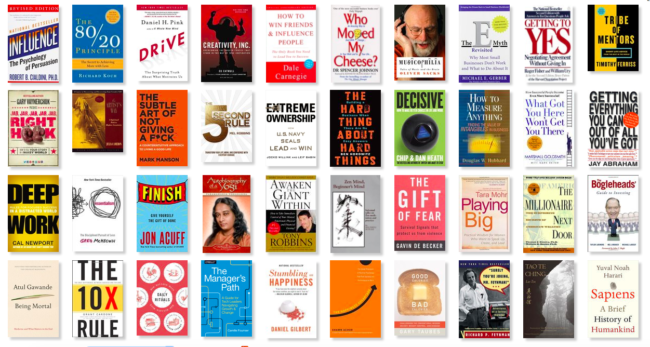
Every morning before I start work, I devote an hour to personal development (largely non-fiction) reading while I let my cup of coffee do it’s magical work. Reading is the best way to kickstart my workday – it’s flipping the switch: from brain fog to focus. Sometimes I need a mere 15 minutes, other times, I take the whole hour if I’m enjoying what I’m reading. (On the flip side, I read fiction and cookbooks in the afternoon and evening to wind down.)
Here’s [version one] of my personal development reading list for 2018. I’ll be supplementing this with plenty of fiction (usually YA novels, sci-fi,and fantasy), and other books as I see fit. I typically write out a quarterly reading list that is a little bit more robust with variety, but I wanted to work through these as a starting point. Some of these books I’ve read before, and I’m looking to read with a new lens to apply to my current work. Many are books that I’ve had on my list for years, and feel like I’m at the right moment to actually get what I want out of them.
How did I pick the books? When I sit to create lists like this, I’m interested in hitting on different aspects of “whole being development” so I try to fill up with a series of business, life, psychology, health, financial, self-help, creative and inspirational reading. I find biographies and history particularly stimulating – if anything, reassuring that you don’t have to have it all together to succeed in life…Also, it’s usually a criteria that they don’t suck. If I really hate the book 50 pages in, I can quit.
Next steps for this list: I try to keep my lists updated as I work through them – there’s no hard and fast rule to sticking to what I’ve added on here. I also want to cross check and make sure that I’m reading a good amount of books written by women, POC and global voices. Already this list is skewing a little too male for my preference. Other things notably missing: I’m a little low on health, wellness, and fitness reading – I’ve had trouble finding great books that have come out in the past decade. (Suggestions welcome here!) I’ll update the list as I make adjustments and read through these.
I’m taking any and all suggestions – do you have a favorite I should read? Anything on here that I shouldn’t waste my time with?
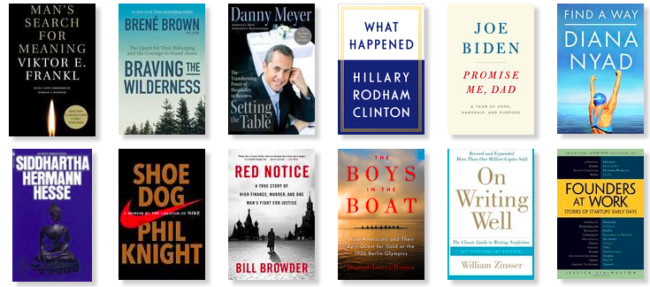
These categories are… loosely organized here. Several of these books fit into more than one of these categories; the top of the list are one’s I’m going to likely start with in the new year.
Starting Here:
[ ] Tribe of Mentors – Tim Ferriss
[ ] Jab, Jab, Jab, Right Hook: How to Tell Your Story in a Noisy Social World – Gary Vaynerchuk
[ ] The Artist’s Way – Julia Cameron
[ ] The Subtle Art of Not Giving a F*ck: A Counterintuitive Approach to Living a Good Life – Mark Manson
[ ] The Five Second Rule: Transform Your Life, Work, and Confidence with Everyday Courage – Mel Robbins
[ ] Extreme Ownership: How U.S. Navy SEALs Lead and Win – Jocko Willink
[ ] Creativity, Inc.: Overcoming the Unseen Forces That Stand in the Way of True Inspiration – Ed Catmull
[ ] Autobiography of a Yogi – Paramahansa Yogananda
[ ] Awaken the Giant Within: How to Take Immediate Control of Your Mental, Emotional, Physical and Financial Destiny! – Tony Robbins
[ ] The Manager’s Path: A Guide for Tech Leaders Navigating Growth and Change – Camille Fournier
[ ] Founder at Work: Stories of Startups’ Early Days – Jessica Livingston
Classic-ish Business:
[ ] How to Win Friends and Influence People – Dale Carnegie
[ ] Influence: The Psychology of Persuasion – Robert Cialdini
[ ] The Hard Thing about Hard Things: Building a Business When There Are No Easy Answers – Ben Horowitz
[ ] Decisive: How to Make Better Choices in Life and Work – Chip and Dan Heath
[ ] How to Measure Anything: Finding the Value of “Intangibles” in Business – Douglas Hubbard
[ ] The E-Myth Revisited: Why Most Small Businesses Don’t Work and What to Do About It – Michael Gerber
[ ] What Got You Here Won’t Get You There: How Successful People Become Even More Successful – Marshall Goldsmith
[ ] Getting Everything You Can out of All You’ve Got – Jay Abraham
Productivity:
[ ] Deep Work: Rules for Focused Success in a Distracted World – Cal Newport
[ ] Essentialism: The Disciplined Pursuit of Less – Greg McKeown
[ ] Who Moved My Cheese? – Spencer Johnson
[ ] Finish: Give Yourself the Gift of Done – Jon Acuff
[ ] The 10x Rule: The Only Difference Between Success and Failure – Grant Cardone
[ ] Daily Rituals: How Artists Work – Mason Curry
[ ] On Writing Well: The Classic Guide to Writing Nonfiction – William Zinsser
[ ] The 80/20 Principle – Richard Koch
Psychology
[ ] The Gift of Fear – Gavin de Becker
[ ] Playing Big: Find Your Voice, Your Mission, Your Message – Tara Mohr
[ ] Drive: The Surprising Truth About What Motivates Us – Daniel Pink
[ ] Getting to Yes: Negotiating an Agreement Without Giving In – Fisher, Ury, Patton
Finance
[ ] The Millionaire Next Door: The Surprising Secrets of America’s Wealthy –Stanley and Danko
[ ] The Bogleheads’ Guide to Investing – Taylor Larimore
Self–Care/ Better Living:
[ ] Being Mortal: Medicine and What Matters in the End – Atul Gawande
[ ] Zen Mind, Beginner’s Mind: Informal Talks on Zen Mediation and Practice – Shunryu Suzuki
Happiness:
[ ] Stumbling on Happiness – Daniel Gilbert
[ ] The Happiness Advantage: The Seven Principles of Positive Psychology That Fuel Success and Performance at Work – Shawn Achor
Health, Wellness, the Body:
[ ] Good Calories, Bad Calories: Challenging the Conventional Wisdom on Diet, Weight Control, and Disease – Gary Taubes
[ ] Musicophilia: Tales of Music and the Brain – Oliver Sachs
Biography or Autobiographical
[ ] What Happened – Hillary Clinton
[ ] Promise Me Dad: A Year of Hope, Hardship, and Purpose – Joe Biden
[ ] Find a Way – Diana Nyad
[ ] Shoe Dog: A Memoir by the Creator of NIKE – Phil Knight
[ ] Red Notice: A True Story of High Finance, Murder, and One Man’s Fight for Justice – Bill Browder
[ ] The Boys in the Boat: Nine Americans and Their Epic Quest for Gold at the 1936 Berlin Olympics – Daniel James Brown
Other:
[ ] Surely You’re Joking, Mr. Feynman! Adventures of a Curious Character – Richard Feynman
[ ] Tao Te Ching – Lao Tzu
[ ] Sapiens: A Brief History of Humankind – Yuval Harari ; THEN Homo Deus
[ ] Man’s Search for Meaning – Viktor Frankl
[ ] Braving the Wilderness: The Quest for True Belonging and the Courage to Stand Alone – Brené Brown
[ ] Setting the Table: The Transforming Power of Hospitality in Business – Danny Meyer
[ ] Siddhartha – Hermann Hesse
Other people’s lists of note which I used for some inspiration while putting together this list:
A few other notes:
On Application: I think it was Darren Hardy who mentioned – you are better off reading one business book and applying it fully than binging on business books and not acting on what you’ve learned. To this end, every book I read I try to apply a portion if not multiple aspects to my work. Most people read and don’t apply what they’ve learned… and that’s a shame. To push myself towards doing more of this, I’ve started taking notes in my books (GASP!), testing and applying.
But sometimes I just read for the sake of reading. One thing that I’ve learned in the past few years is that one of the best results of reading non-fiction is actually just a simple context switch and brain shift in order to get myself going in the morning. So I try to use reading as a multi-purpose tool.
On Writing: The past few years I’ve been trying to commit and re-commit to sharing what I’ve learned from my reading (as opposed to hoarding knowledge.) Each year I try to write more than I did the last. It takes a bit of a mind shift from reading for one’s self, to reading with the intention of sharing the knowledge and learnings. Friends, hold me to this! (Yes, I give you permission to guilt and shame me for not writing about what I’m reading.
Do you have a 2018 reading list? Have you ever done a reading challenge? I’d love to hear about it.
by Sam Tackeff | Dec 16, 2017 | Ingredients, Meal Planning, Quick and Easy, Shopping
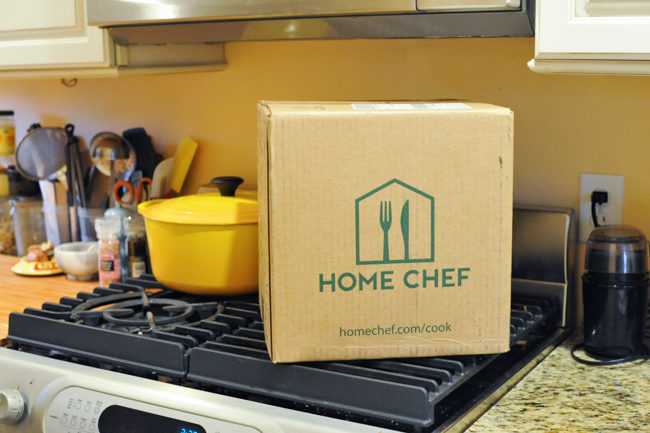
Well hello there! What’s cooking? I’m back in the kitchen today with a quick profile of another meal kit delivery service for your reading pleasure.
This installment? I try it: a week of “Home Chef”.
A few years back I took on a new kitchen challenge: to cook, taste, and review a variety of meal kits. In a sea of meal kits, I wanted to answer the age old question of: which meal kit is the best on the market right now?
Among the initial entrants, I tried Sakara (not actually a kit – it’s really $$$ organic meal delivery), Purple Carrot (vegetarian), and then many months of Blue Apron which I was then too lazy to cancel. On the plus side, it was good for a more comprehensive review, which you can read here.
At the end of the day, I found that cooking meal kit takes me a lot more effort than doing my own meal planning, shopping, and cooking. It’s also a good amount of waste packaging wise. And truthfully, I’m a better and more creative cook.
Nevertheless, I’m still charmed by the appeal of having a box of goodies show up on my doorstep and someone occasionally taking over the mealtime decision making, so I’m continuing my mini quest and trying different boxes every so often in order to share with you all, dear readers.
Disclosure: Home Chef knows nothing about me, but I did get a free box through their refer a friend program, and the links to Home Chef are affiliate links which give you $30 off your kit, and give me more free food. (If you order enough kits, you can send a free box to a friend; on par with most of the other meal kit customer acquisition programs.)
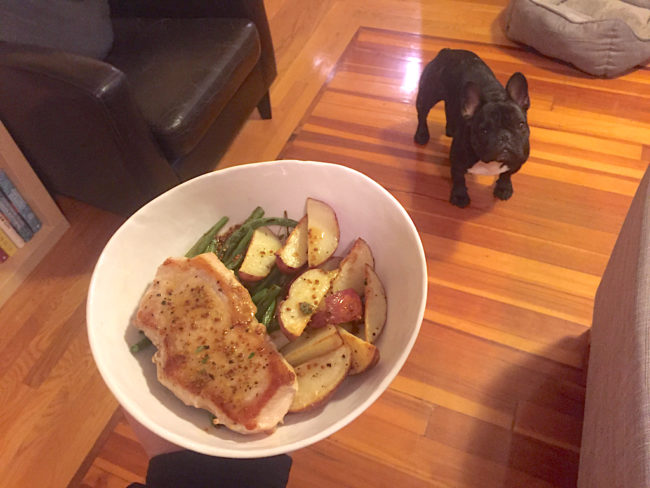
The details:
Home Chef Box overview – Home Chef is a more general meal kit without any particular slant. I’d characterize them as American home cooking with a hint of global food exploration but nothing overly fussy or too adventurous for the average palate. The company is based in Chicago, and has raised 57 million through series b (see Crunchbase), which is about a quarter of the funding of Blue Apron who was just shy of 200 million pre IPO and less compared to HelloFresh’s 365 million pre IPO.
How much does Home Chef cost?
This is a little complicated: $9.95 per serving – two servings of two dishes in the box; although you can add on lunches (most are $7.99/serving), seasonal fruit ($4.95/serving), or a smoothie ($4.95/serving) as extra which is a nice touch. If you glance, it’s not totally clear that the add ons will charge you for two servings. You can also choose some weeks from “Premium Meals” which seem to include bigger pieces of steak or lamb for 19.95 a serving, but these aren’t offered every week. And if your order is under a certain amount, you get charged the $10 for shipping. So the minimum box comes in at around $49.80 and goes up from there.
What kind of meat and produce does Home Chef have?
Generally, I found Home Chef’s to have an overall decent quality of produce and meat, although, notably NOT organic. (Most of my personal purchasing is organic and I get my vegetables and meat from a farm share; so I don’t think I’d get the box regularly for this reason alone.) Nothing seemed wilted or bruised, and generally everything was tasty. The fresh sausage packed in the lasagna skillet likely wouldn’t have past the two days I waited to cook it though even though it suggests that it would last 6 days on the recipe card.
The service strikes me as less “foodie” focused compared to, say, Blue Apron’s inserts about the farms and farmers (which sometimes strikes me as greenwashing but I still buy into), although does suggest wine pairings.
What kind of recipes does Home Chef have?
The recipes and ingredients on Home Chef are notably a little bit more basic than other services. I ended up going with two fairly simple dishes which worked well, although I’d be curious as to how the flavors are on the more global recipes. Each week you get to choose from several options on the list.
For my box, I chose the grilled pork chop with whole grain dijon sauce, and the Italian sausage lasagna skillet.

How easy are the Home Chef recipes to follow?
As you can see in the picture of the sheet; the recipes are fairly simple and bulleted. You are encouraged to read through the whole recipe before starting (which is good practice, but always a useful reminder). I found that the recipes might leave a little too much room for interpretation for a novice cook, but I got along just fine. There were a few steps in each recipe that weren’t what I’d have written, but in the end, my dishes turned out alright. For example: the skillet called for “one medium oven-safe pan” although the picture seemed to be of a cast iron, I wasn’t sure what actual size cast iron counts as “medium” (8 inch? 10 inch?), so opted for a pyrex.
Decently quick to cook. Unlike other meal kits, the Home Chef recipes seemed to take less steps and take me less time overall to cook. Each dish was closer to 25-30 minutes of cooking (compared to Blue Apron which routinely had me chopping, prepping, etc. for 45-60 minutes.) Home Chef was closer to the promise of ease than other kits that I’ve tried so far.
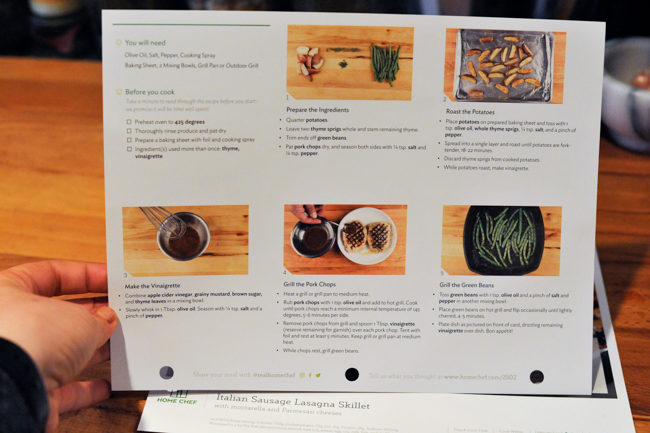
In your first delivery, Home Chef sends you a little plastic binder to save your recipe cards. It’s a little flimsy, but was a nice touch.
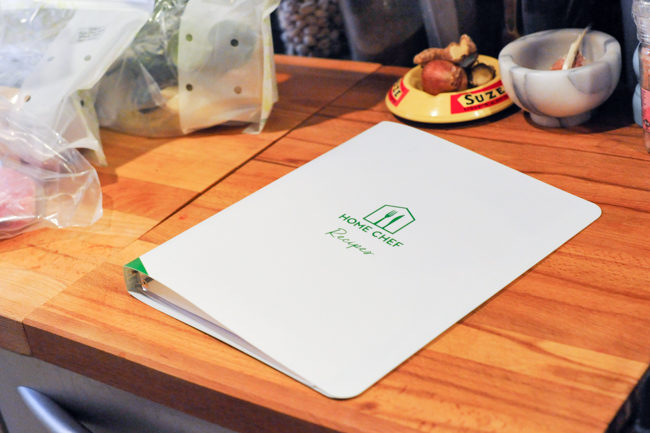
What’s in the Home Chef Box?
Aside from the recipe cards, the box itself is filled with individual bags – one for the combined meats, and then individually packaged bags for the separate meals themselves which include all produce, spices, etc.
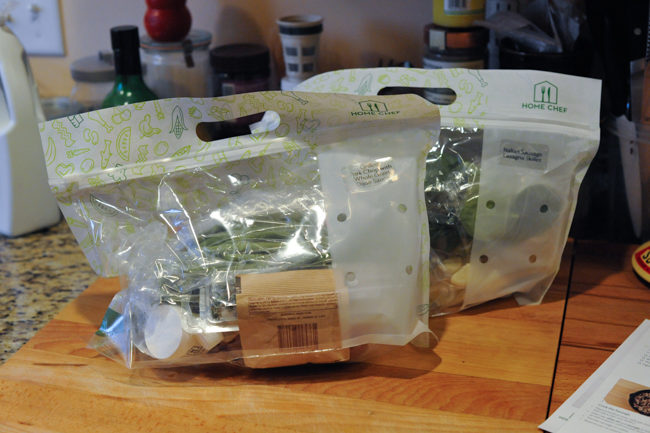
* Packaging – I’m not sure that anyone will solve this – it’s about the same size box as Blue Apron; each meal comes in it’s own little plastic bag, and the meats are separated into bags, the box here is filled with an icepack, and a soft plastic material filled with batting of some type. Still a PITA to break down and recycle, but what can you do?
I’ll note here that my Frenchie Bertram is not afraid of much in life, with the clear exception of cardboard boxes from meal kit delivery services. Which he wanted to let me know was NOT OKAY for me to put on “his gel mat bed” in front of the stove while I took this photo. If I could have added the audio file from his complaints here, I would have.
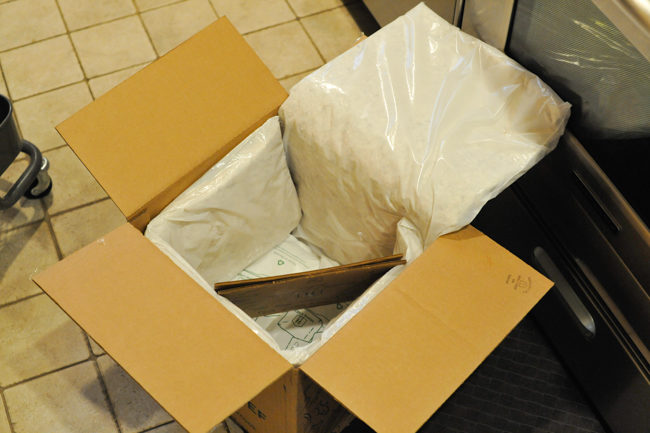
How much food is in each Home Chef box? Is Home Chef healthy?
Portion Sizes – appropriate for two light-moderate eaters. I was still hungry after both dishes. I tend to supplement meal kits anyway with more vegetables, but volume alone wouldn’t have been enough for me to be satisfied, even though calorically the dishes were in the 500-700 calorie range. I’d love to see more vegetables to round out the dish.
Nutrition: the recipes themselves do have ingredients and high level macros listed (calories, carbs, fat, protein and sodium) for those interested in tracking. You can choose from a variety of different diet preferences, including vegetarian, low carb, and calorie conscious meals.
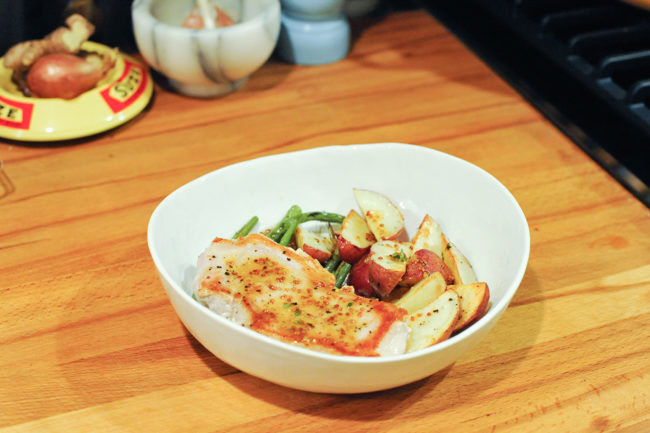
Other notes: I had to email customer service to move my first deliver date (before cut-off) because I ended up having a last minute travel situation. They were quick, competent, and pleasant to deal with.
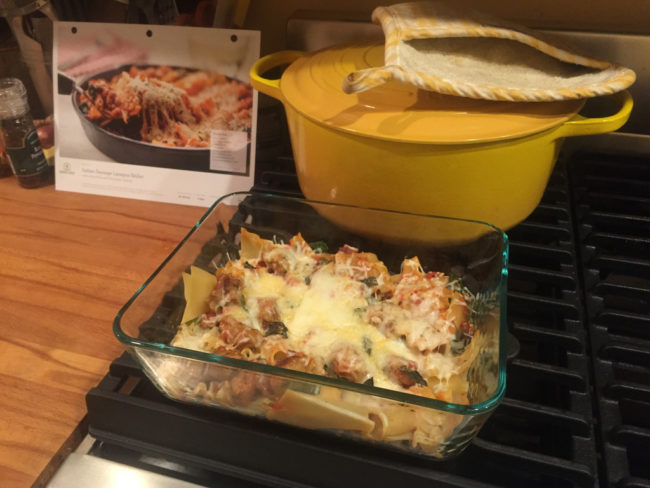
The Bottom Line:
Did we enjoy the Home Chef meals? Yes. Both meals tasted good. The pork dish was slightly better looking in presentation, but flavors were very good with both. As mentioned above, would have liked a little bit more vegetable for volume! I think overall I prefer a slightly more spiced and creative dinner if ordering a meal kit, but Home Chef does deliver on overall taste if you don’t mind a slightly boring meal.
Would we order Home Chef again? Possibly. I haven’t actually canceled the service, so it’s quite likely that I might try another box to compare and update this review.
Want to read more meal kit reviews? Here’s my comprehensive review of several months worth of Blue Apron meals, and I’ll be updating this post as I try more kits.
by Sam Tackeff | Oct 6, 2017 | Wellness
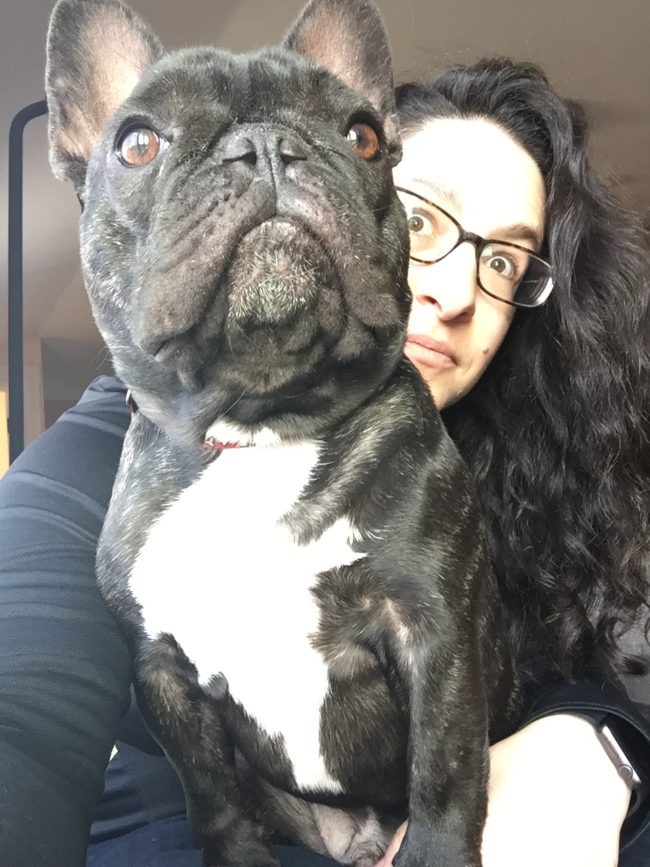
Here’s a non-exhaustive list of things that I do when I feel like not doing any work.
It’s that awful feeling. You wake up, have a long list of things to do for the day, and suddenly you are overwhelmed, grumpy, in need of a caffeine drip, and you are just NOT READY start the day.
Not to mention when that feeling hits the middle of the day and your to-do list is long – you’ve been on a roll, things are going well, and then BOOM, you hit the wall. Whenever the mood strikes; here are some ideas to get yourself back on track:
[START NOW] When I’m not ready to start the day:
* Make the bed. This seems to be in every productivity book written in the past decade. Because it works.
* Take my vitamins. Chances are I’m lacking Vitamin B. Or a swig of probiotic from the fridge. I find that a small positive behavior can really set me on the path of better habits for the day. This is one of my “anchor habits” that other good habits build on.
* My elaborate morning coffee or tea ritual. Kettle on, grind the beans, get the coffee, curl up with the dog on the couch for 45 minutes before starting the day.
* Read my way to a better place: at least 15 minutes of personal development books – Michael Hyatt, Brian Tracy, Brene Brown, Stephen Pressfield, anything from the self-improvement, productivity, business aisle. Usually this gets my brain thinking “work-mode”.
[Get UNSTUCK] When I’m feeling blocked:
* Just 10 minutes. Set a timer, and commit to doing 10 minutes of work on a task. This also works for those days you don’t want to move or exercise.
* Pull out my notebook. 25 minutes to get stuff on paper. Sometimes 50. What’s scaring me? What am I dreading? What is blocking me?
* Walk outside for 10 minutes. If I’m having trouble transitioning between work projects, I’ll take 15. A change of scenery is a great way to shock yourself out of a negative thought pattern.
* Put on a Podcast. Being Boss, RadioLab, Tim Ferriss. Whatever’s on my podcast list. Usually I pop in the headphones and take the dog for a walk to listen if he’s home with me.
* Create something small and tangible. There’s power in making things. Knitting, cooking, a flower arrangement from the yard.
* Hardboil a dozen eggs. I work from home. There’s something comforting about batch cooking and knowing that I’ll have something good to snack on throughout the day. Also, if I don’t manage to get “enough” stuff done, at least I’ve hard boiled some eggs.
* Gratitude list. Sometimes I start with just three things that I’m thankful for – even if it feels like there’s not much that can go on the list for today.
* Taking 15 minutes to write a short retrospective of my week so far. What worked well this week? What should I stop doing? What should I improve?
* Take the day off. (Sometimes you just need to take the nuclear option.) It’s important to commit to my work, but not at the total expense of my health and sanity. I’ve been working at getting better at stepping away from my work entirely. There’s no shame in taking a well needed personal day.
* Phone a friend. I’ve been getting better at reaching out – be it a friend, a biz-friend, or my mom. Short phone calls have been useful to reset when I’m struggling.
* Take selfies with my dog. Somehow animals make everything better. If you don’t have a dog, cat, bunny, snake, or other lovable friend – watching youtube videos of cute baby animals is a good alternative.
I’d love to hear some of your best ways to reset a rough work day! How do you get back on track?
Need more ideas for productivity and self care? My next mini-course round launches on October 16th. It’s only $29 and designed to get you back on track and focused on yourself so you have the energy to do great things in the world.
SaveSaveSaveSaveSaveSave
SaveSave
SaveSaveSaveSaveSaveSave
SaveSave













